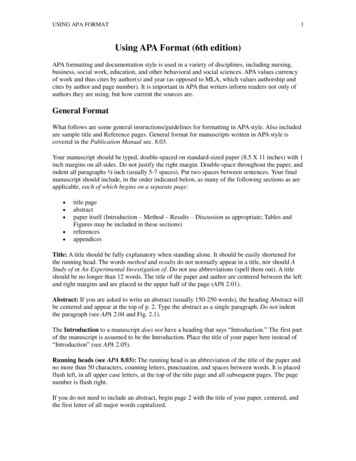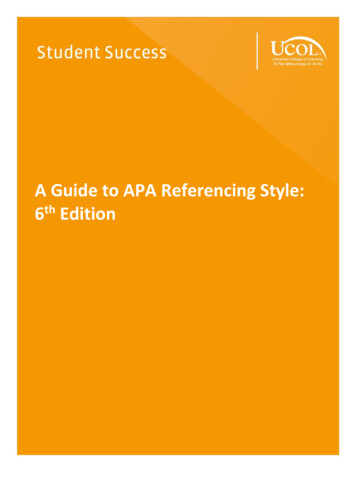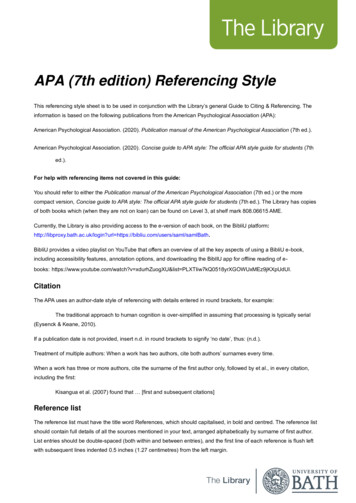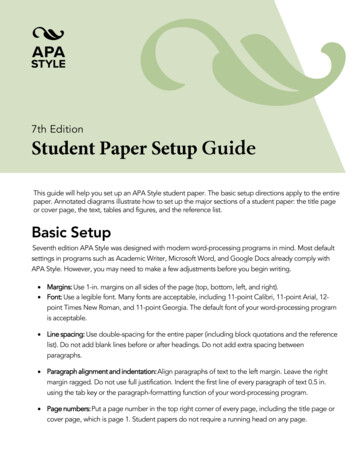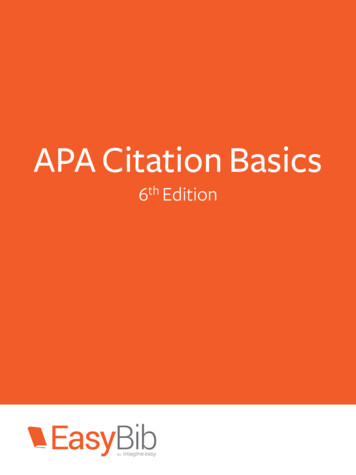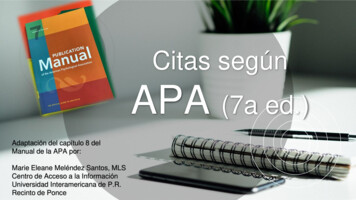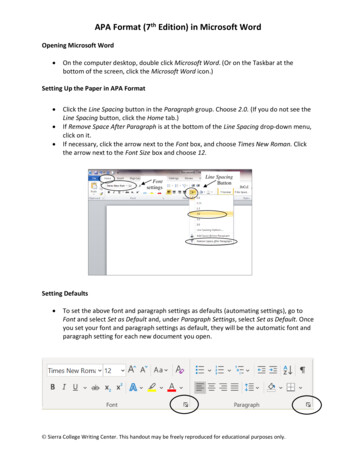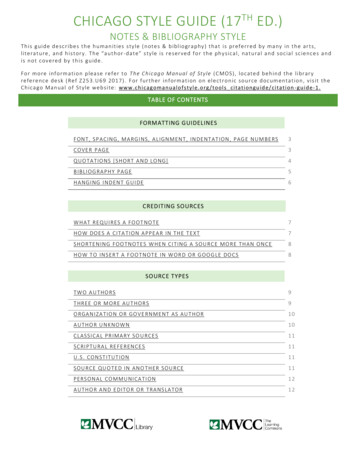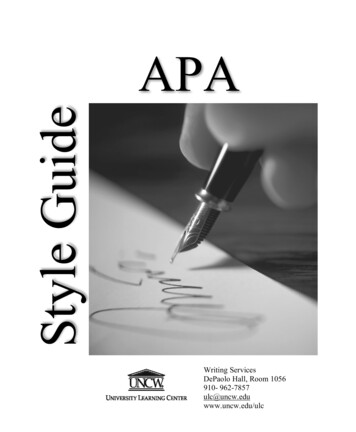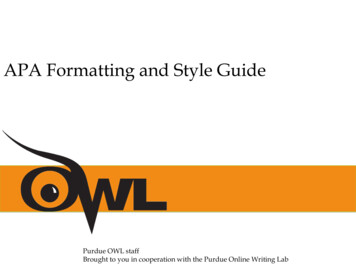
Transcription
APA Formatting and Style GuidePurdue OWL staffBrought to you in cooperation with the Purdue Online Writing Lab
What is APA Style?The American Psychological Association (APA) citation styleis the most commonly used format for manuscripts in thesocial sciences.APA regulates: Stylistics In-text citations References
Point of View &VoicePersonal pronouns where appropriate : “We conducted an experiment ” : “The authors conducted an experiment .”Active voice rather than passive voice : “We asked participants questions.” : “The participants have been asked questions bythe researchers.”
LanguageLanguage in an APA paper should be: Clear: be specific in descriptions and explanations Concise: condense information when you can Plain: use simple, descriptive adjectives and minimizefigurative language
Types of APA PapersThe Literature Review: Summarizes scientific literature on a particular researchtopic Includes: a title page, introduction, and a list of references
Types of APA PapersThe Experimental Report: Describes your experimental research Includes: a title page, abstract, introduction, methods, results, and discussion sections, a list of references, appendices, tables, and figures
Types of APA PapersIf your paper fits neither category: Follow the general format Consult the instructor Consult the APA Publication Manual
General APA FormatYour essay should: be typed, double-spaced, have 1” margins, use 10-12pt. Standard font (ex. Times New Roman), and be printed on standard-sized paper (8.5”x 11”)[Note: If you are writing a manuscript draft, APA suggests using two spacesbetween sentences to aid readability (see pp.87-88 in the APA manual).]
General APA FormatEvery page of your essay should: Include a page header (Title, all caps) in the upper lefthand corner and the page number in the upper right
General APA FormatYour essay shouldinclude four majorsections:ReferencesMain BodyAbstractTitle page
Title PagePage header:(use Insert PageHeader)title flush left pagenumber flush right.Title:(in the upper half of thepage, centered)name (no title ordegree) affiliation(university, etc.)
Abstract PagePage header: doNOT include“Running head:”Abstract: centered,at the top of the pageWrite a 150- to 250word summary of yourpaper in an accurate,concise, and specificmanner.
Main Body (Text) Number the first text page as page number 3 Type and center the title of the paper at the top of thepage Type the text double-spaced with all sections followingeach other without a break Identify the sources you use in the paper inparenthetical, in-text citations Format tables and figures
Reference Page Center the title (References)at the top of the page. Do notbold it. Double-space referenceentries Flush left the first line of theentry and indent subsequentlines Order entries alphabeticallyby the surname of the firstauthor of each work
References: Basics Invert authors’ names (last name first followed by initials) EX:“Smith, J.Q.” Capitalize only the first letter of the first word of a titleand subtitle, the first word after a colon or a dash in thetitle, and proper nouns. Do not capitalize the first letter ofthe second word in a hyphenated compound word. EX: The perfectly formatted paper: How the PurdueOWL saved my essay.
References: Basics Capitalize all major words in journal titles Italicize titles of longer works such as books andjournals Do not italicize, underline, or put quotes around thetitles of shorter works such as journal articles oressays in edited collections
Making the Reference ListAPA is a complex system of citation. When compiling the referencelist, the strategy below might be useful:1. Identify the type of source:Is it a book? A journal article? A webpage?2. Find a sample citation for this type of sourceCheck a textbook or the OWL APA 60/01/3. “Mirror” the sample4. Make sure that the entries are listed in alphabetical order and thatthe subsequent lines are indented (Recall References: Basics)
In-text Citation: BasicsIn-text citations help readers locate the cited source in theReferences section of the paper.Whenever you use a source, provide in parenthesis: the author’s name and the date of publication for quotations and close paraphrases, provide theauthor’s name, date of publication, and a page number
In-Text Citation:QuotationsWhen quoting: Introduce the quotation with a signal phrase Include the author’s name, year of publication, and page number Keep the citation brief—do not repeat the information
In-Text Citation:Summary or ParaphraseProvide the author’s last name and the year ofpublication in parenthesis after a summary or a paraphrase.
In-Text Citation:Summary or ParaphraseInclude the author’s name in the signal phrase, followed bythe year of publication in parenthesis.
In-Text Citation:Summary or ParaphraseWhen including the quotation in a summary/paraphrase, alsoprovide a page number in parenthesis after the quotation:
In-Text Citation:Signal WordsIntroduce quotations with signal phrases, e.g.:According to Xavier (2008), “ .” (p. 3).Xavier (2008) argued that “ ” (p. 3).Use such signal verbs such as:acknowledged, contended, maintained,responded, reported, argued, concluded, etc.Use the past tense or the present perfect tense of verbs in signal phraseswhen they discuss past events.
In-Text Citation:Two or More WorksWhen the parenthetical citation includes two ormore works, order them in the same way they appear in the referencelist—the author’s name, the year of publication—separated by a semicolon.
In-Text Citation:Works with Two AuthorsWhen citing a work with two authors, useIn the signal phrase, use “and” in between the authors’namesIn parenthesis, use “&” between names
In-Text Citation:Works with 3-5 AuthorsWhen citing a work with three to five authors, identify all authors in thesignal phrase or in parenthesis.(Harklau, Siegal, & Losey, 1999)In subsequent citations, only use the first author's last name followed by"et al." in the signal phrase or in parentheses.(Harklau et al., 1993)
In-Text Citation:Works with 6 AuthorsWhen citing a work with six and more authors, identify the first author’sname followed by “et al.”Smith et al. (2006) maintained that .(Smith et al., 2006)
In-Text Citation:Unknown AuthorWhen citing a work of unknown author: use the source’s full title in the signal phrase cite the first word of the title followed by the year of publication inparenthesis.According to “Indiana Joins Federal Accountability System” (2008)OR(“Indiana,” 2008)Titles:Articles and Chapters “ ”Books and Reports italicize
In-Text Citation:OrganizationWhen citing an organization: mention the organization the first time you cite the source in the signalphrase or the parenthetical citation. If the organization has a well-known abbreviation, include theabbreviation in brackets the first time the source is cited and then use onlythe abbreviation in later citations.
In-Text Citation:Same Last Name/AuthorWhen citing authors with the same last names, use first initials withthe last names.(B. Kachru, 2005; Y. Kachru, 2008)When citing two or more works by the same author and publishedin the same year, use lower-case letters (a, b, c) after the year ofpublication to order the references.Smith’s (1998a) study of adolescent immigrants
In-Text Citation:Personal CommunicationWhen citing interviews, letters, e-mails, etc., include the communicator’sname, the fact that it was personal communication, and the date of thecommunication.Do not include personal communication in the reference list.
In-Text Citation:Electronic SourcesWhen citing an electronic document, whenever possible, cite it in theauthor-date style. If electronic source lacks page numbers, locate andidentify paragraph number/paragraph heading.
HeadingsAPA uses a system of five heading levelsAPA HeadingsLevel12FormatCentered, Boldfaced, Upper & Lowercase HeadingsLeft-aligned, Boldface, Upper & Lowercase Headings3Indented, boldface, lowercase heading with a period.4Indented, boldface, italicized, lowercase heading with period.5Indented, italicized, lowercase heading with a period.
HeadingsHere is an example of the five-level heading system:
TablesLabel tables with an Arabic numeral and provide a title. The label and titleappear on separate lines above the table, flush-left and single-spaced.Cite a source in a note below the table.Table 1Internet users in EuropeCountryRegular UsersFrance9 mlNote: The data are adapted from “The European Union andRussia” (2007). Retrieved from http://epp.eurostat.ec.europa.eu
FiguresLabel figures with an Arabic numeral and provide a title. The label and thetitle appear on the same line below the figure, flush-left .You might provide an additional title centered above the figure.Cite the source below the label and the title.Figure 1. Internet users in Europe. Adapted from The European Union andRussia: Statistical comparison by Eurostat Statistical Books, 2007,Retrieved from http://epp.eurostat.ec.europa.eu
Additional ResourcesThe Purdue OWL: http://owl.english.purdue.eduThe Purdue Writing Lab @ HEAV 226Composition textbooksPublication Manual of the American Psychological Association, 6th ed.APA’s website: http://www.apastyle.org
The EndAPA Formatting and Style GuideBrought to you in cooperation with the Purdue Online Writing Lab
Language in an APA paper should be: Clear: be specific in descriptions and explanations Concise: condense information when you can Plain: use simple, descriptive adjectives a
